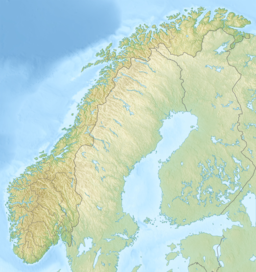| Toke | |
|---|---|
 View of the lake | |
 Map of the lake | |
| Location | Bamble, Kragerø, Drangedal (Telemark) |
| Coordinates | 59°1′54″N 9°12′28″E / 59.03167°N 9.20778°E |
| Primary inflows | Heldøla, Solbergelva and Tørneselva |
| Primary outflows | Lundereidelva |
| Catchment area | 1,156 km2 (446 sq mi) |
| Basin countries | Norway |
| Surface area | 30.3 km2 (11.7 sq mi) |
| Average depth | 42.5 m (139 ft) |
| Max. depth | 147.5 m (484 ft) (Rørholtfjorden) |
| Water volume | 1.29 km3 (0.31 cu mi) |
| Shore length1 | 185.5 km (115.3 mi) |
| Surface elevation | 60.35–55.75 m (198.0–182.9 ft), regulated |
| References | NVE[1] |
| 1 Shore length is not a well-defined measure. | |
Toke is a lake in Telemark county, Norway. The lake is located primarily in Drangedal Municipality, but it also extends slightly into Kragerø Municipality and Bamble Municipality. The lake consists of several areas: Upper Toke and Lower Toke, which is connected via Straumen, literally 'the stream'. At the north end of Upper Toke is the village of Prestestranda. In the south, the eastern arm of Lower Toke (Rørholtfjorden) reaches into Bamble municipality and the southern part reaches into Kragerø, where its outlet is the river Lundereidelva where the Dalfoss hydroelectric plant is located. The lake, with its inflow, constitutes the majority of the Kragerø watershed.
With a surface of about 30 km2 (12 sq mi) and a drainage basin of 1,156 km2 (446 sq mi),[2] Toke is a substantial body of water in Telemark. Its approximately 185 km (115 mi)-long shoreline, a large part of which consists of an old lakebed with clay and deposits of silt, is strongly exposed to erosion because of development for power production.
With its long shoreline and innumerable larger and smaller islands and narrow bays, Toke is a popular destination for boaters and sport fishers. Trout, Arctic char, whitefish, and perch are all found in the lake. The municipality's investment areas for the development of leisure housing are mainly located around Tokevassdraget and in the Gautefall area. The municipality's plans for these areas provide for increased use of the areas for outdoor recreation.[3]
- ^ "Innsjødatabase". NVE.no (in Norwegian). Retrieved 5 September 2023.
- ^ "NVE Atlas". Norwegian Water Resources and Energy Directorate. Archived from the original on 12 March 2019. Retrieved 25 March 2022.
- ^ "Kommuneprofil Drangedal 2020" (PDF). Vestfold og Telemark fylkeskommune (in Norwegian). Archived from the original (PDF) on 31 October 2020.

